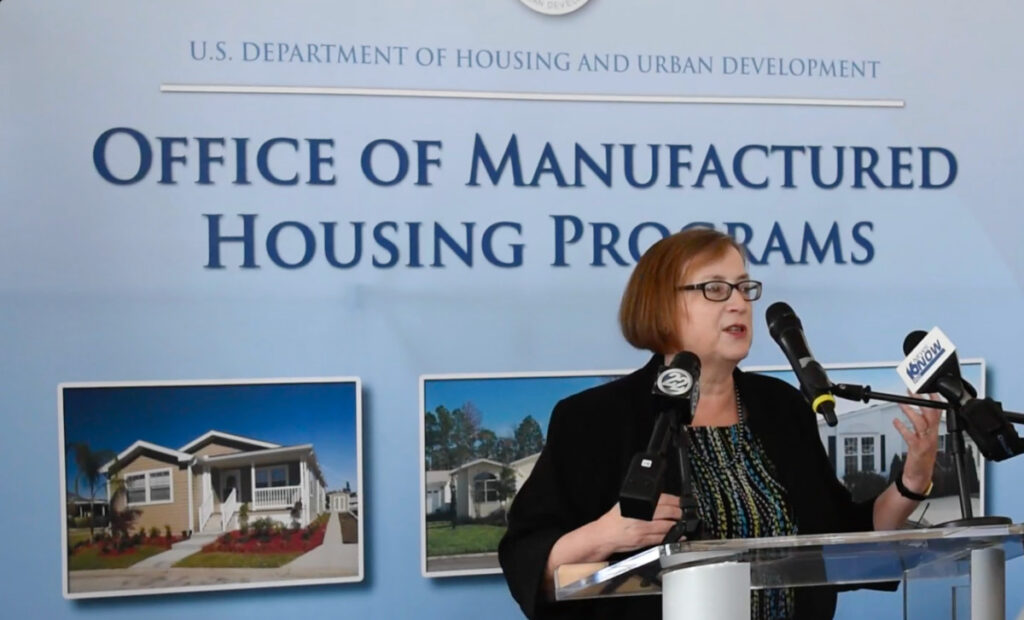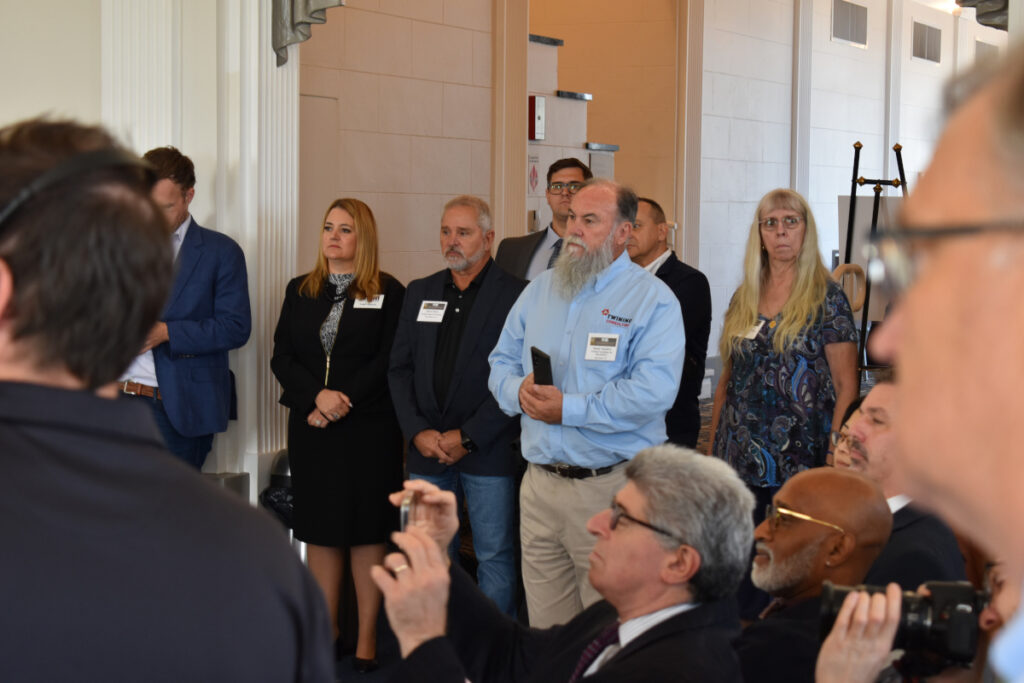
Most Comprehensive Update to the ‘HUD Code’ in Decades
The U.S. Department of Housing and Urban Development held a press conference in Elkhart, Ind., to announce the most comprehensive update to the manufactured home construction and safety standards in nearly three decades, with 87 changes in whole, most notably the expansion of the HUD code to include multi-residential structures — duplex, triplex, and quadplex homes.
A majority of the updates will be effective in 180 days, though industry builders can begin construction of the multi-residential manufactured homes immediately.
“There is a waiver which allows manufacturers to start immediately making those multi-unit products that we talked about,” Teresa Payne, administrator of the office of manufactured housing programs at HUD, told the audience at Hotel Elkhart in Northern Indiana. “Because we know the market is demanding those and we want to get those out as quickly as possible.”
Federal Housing Administration Commissioner Julia Gordon said the expansion of home types allowable within the HUD code provides the ability to supply factory-built homes nationwide in a greater variety of settings.
“You want to be able to match the type of housing that’s in those communities,” Gordon said. “Whether it’s having homes that can have kind of zero lot line and can just fit into a particular area, or having an actual home with two separate living quarters.”
Industry professionals have expressed an interest in having multi-residential homes to increase density in a variety of settings, including manufactured home communities, on or near college campuses, for workforce housing, or blended into housing developments along side traditional single-section or multi-section manufactured homes and standard site-built homes. Similar to the usage of an ADU, the units within a primary residence also can be used to lease, or provide housing for an aging relative.
The increased variety of home types along with the industry’s long-held advantage in speed to market, Gordon said, can play a major role in “closing the gap” on the U.S. housing shortage. Current estimates on the U.S. housing shortage vary between 3-5 million in deficit. Gordon said the inclusion of duplex to quadplex residences will provide homes where their needed, and employment opportunities too.
To use site-built construction in development means an elongated process, and labor pools that move from market to market in teams rather than the stability of community and a single work site. Factory jobs are more stable and predictable and the use of homes from the factory eliminates the wait.
“Manufactured homes are an affordable housing option for Americans across the country,” HUD Acting Secretary Adrianne Todman said. “This update of the HUD Code is long overdue and will help increase production while also ensuring modern designs to suit the needs of families.”
Payne emphasized work with municipalities in saying site-built homes take “multiples of the amount of time it’s going to take to have this whole new neighborhood right there… right near jobs and good schools and all sorts of things people think about when they think about where they want to live and when they want to buy a house.

“We want to be giving that federal voice, that imprimatur, if you will, to what is happening out in this exciting sector,” Gordon said. “We’re missing millions of homes right now. We have lots of young families, for example, who aren’t moving out from their parents and forming a household because they simply cannot find, let alone afford, a place live.
“This is something we can scale,” she said. “Building them in a factory rather than on site, you can really develop your workforce in an area, you can really be a force for jobs and we’ve seen more and more localities interested in ‘Well, could we locate one of those plants here?’ It’s really exciting but it just takes raising this up over and over in the national conversation.”
The construction and safety code, commonly referred to as the HUD code, was signed into law 50 years ago, and Elkhart is the birthplace of the manufactured housing and RV industries. Elkhart, the location of the RV/MH Hall of Fame, hosted the Manufactured Housing Consensus Committee’s September meeting, at which the code updates were announced.
More than 22 million people live in manufactured homes, and last year the industry produced 89,717 new homes.
“Every rule regarding manufactured housing starts here, at MHCC meetings,” Payne said. “We continue to play a critical role in increasing the affordable housing stock. Today’s manufactured homes are durable, efficient, sustainable, safe, and, most importantly, affordable. That’s why our program is essential to providing housing to everyday Americans whether it’s for purchase, for rent, for a first-time homebuyer, or a senior looking to downsize. And for families seeking to build generational wealth.
“The HUD code, as we call it, has continued to evolve to meet the needs of modern consumers, which has increased the acceptance of manufactured housing,” she said.

More Key Changes to the HUD Code
Open floor plans, truss designs, and specifications for attics
The updated requirements for exterior door separation and structural design enable open floorplans that maintain fire safety, clarify unclear provisions, and enable optimization of truss design. In addition, the final rule provides clarity regarding structural design requirements for attics.
Ridge roof designs
Revised definitions and regulatory language allow certain specified roof ridge designs (peak cap and peak flip roof assemblies) without a requirement for specific on-site inspections by a HUD-approved agency, except for certain exclusions. This type of roof installation is common through the industry and uses technology that is time-tested. This update is beneficial for manufacturers and consumers by incorporating more recent design practices into the regulations and eliminating unnecessary inspections and associated costs.
Materials that facilitate modern design approaches and improve quality
Updates to reference standards for materials (wood, steel, piping) and products align with other building standards, allow the use of more modern design approaches and installation of alternative materials, and improve the quality and safety of homes for consumers.
Accessibility improvements
Modifications to standards for accessible showers comply with national disability standards for roll in showers. This eliminates the need for HUD alternative construction approval and reduce cost and burdens for manufacturers and consumers.
Modern and energy-saving appliances
Updated and newly added standards allow for the use of more modern and energy efficient appliances, including gas-fired tankless water heaters, eliminating the need for HUD alternative construction approvals for use of such appliances.
Additional process efficiencies that save time and reduce costs
Improved language stipulating prerequisites for the process of obtaining installation licenses increase flexibility for installers; updates to water system piping testing procedures decrease on-site testing time; and utilization of appliance QR codes for manuals and information will reduce paperwork and bookkeeping.
Go to the Federal Register Sept. 16 for a complete list of 2024 HUD code changes.
Input on HUD Code Changes from MHI
The Manufactured Housing Institute issued a statement commending the U.S. Department of Housing and Urban Development for its long-awaited updates to the Federal Manufactured Home Construction and Safety Standards. As the nation navigates an affordable housing shortage, manufactured housing offers quality and affordability to Americans who need and deserve both.
“Today’s updates to the construction code for manufactured housing will support the industry in delivering homes with innovative designs and modern features, bringing attainable home ownership to more people across the country,” MHI CEO Lesli Gooch said.
Gooch said she applauds the administrative waiver for the production and immediate delivery of in-demand one- to four-unit manufactured homes as “a vital move toward addressing housing challenges in high density areas.”
MHI expressed concern about the “tight 180-day timeline to enact these substantial new changes” including 74 updates to reference standards, 16 new standards, and three regulatory text changes.
The proposed revisions and updates to the HUD code are critical, MHI stated. They clear out the backlog of items previously approved by the Manufactured Housing Consensus Committee, which have been pending HUD approval and implementation for years. To avoid future backlogs, MHI urges HUD to provide more regular updates to the HUD code to alleviate construction challenges and streamline attainable home ownership nationwide.
MHInsider is the leader in manufactured housing news and is a product of MHVillage, the top marketplace for manufactured homes.









